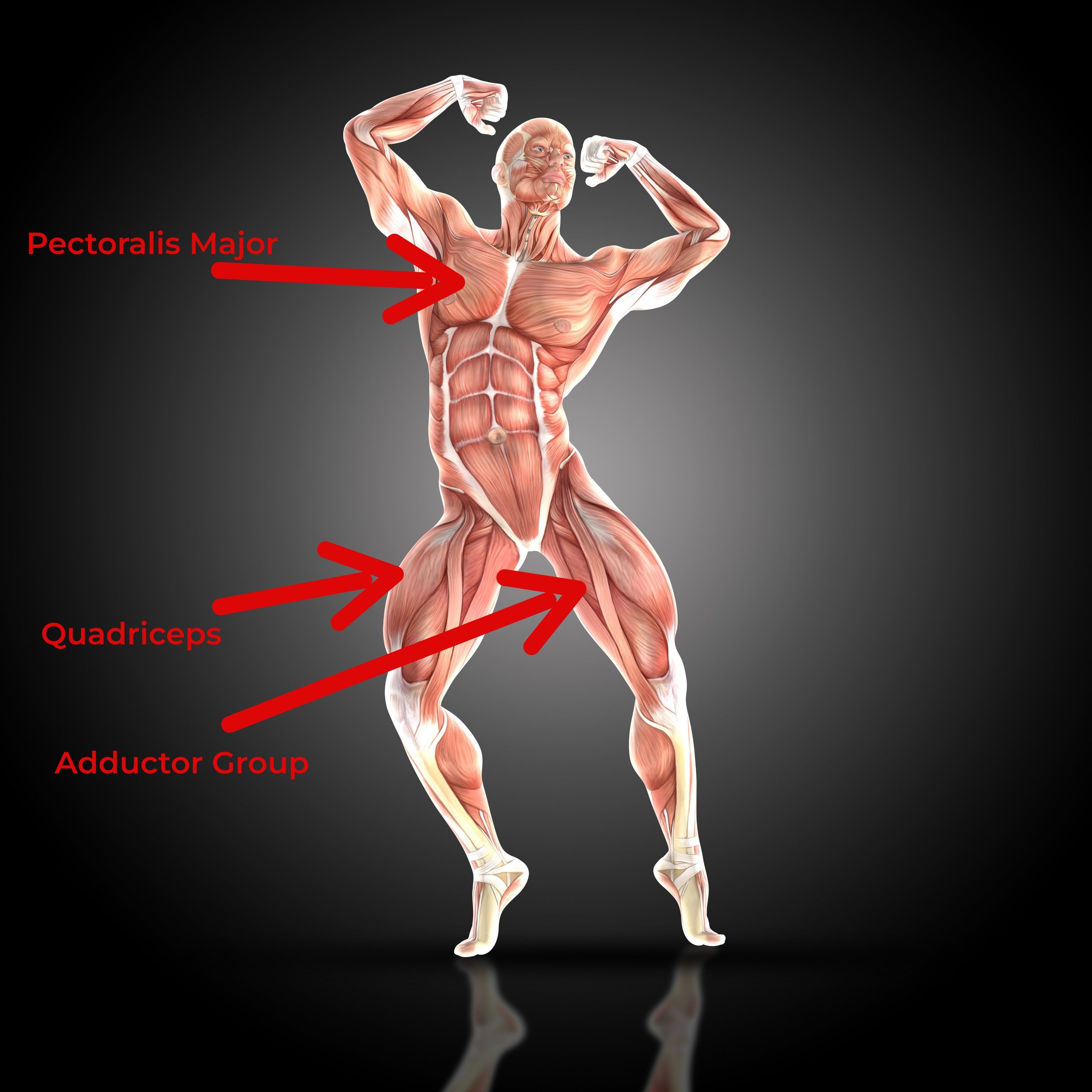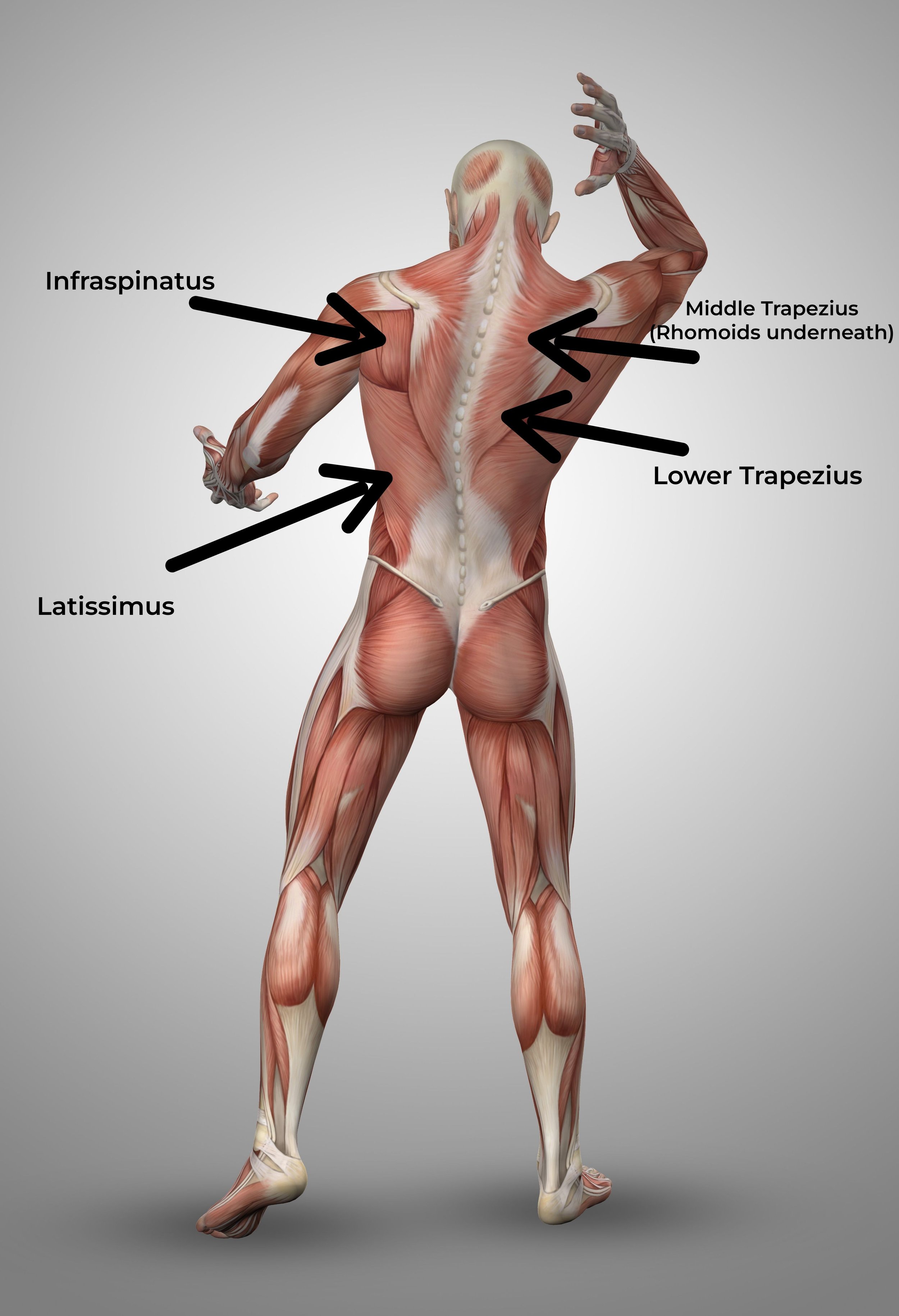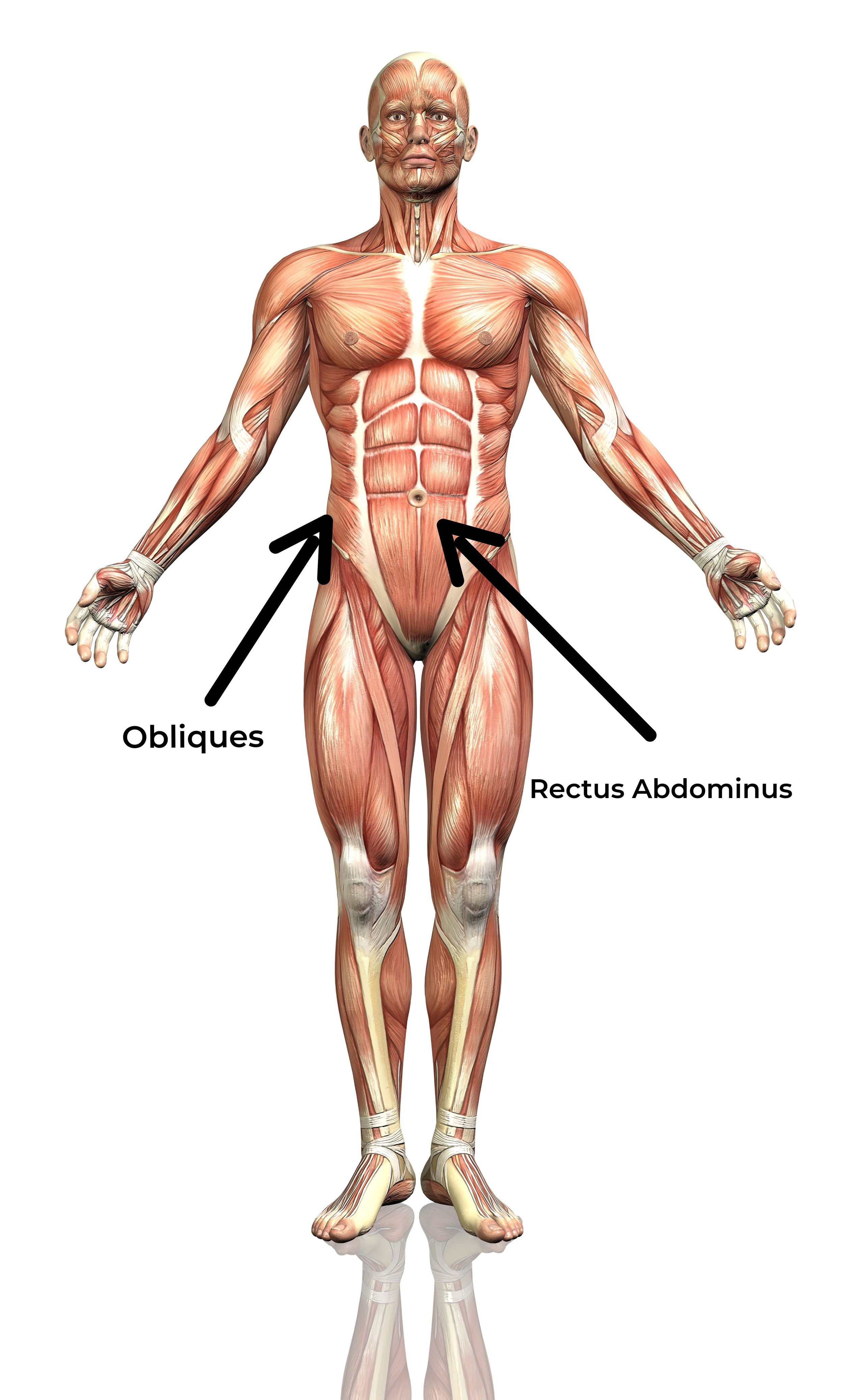EMG: Muscles that Power the Swing
Some people have big muscles, some people have small muscles, but everybody has them. If we didn’t have muscles, we couldn’t move or breathe. We would simply be one of those skeletons you see at the doctor’s office stuck on a metal pole. We certainly could not golf. Everyone knows that it requires muscles to golf, but do you know which ones?
All our muscles have a specific job, they produce movement in a certain direction. It takes great timing and coordination to produce even simple movements like grasping a coffee cup. For complex movements like the golf swing, it’s amazing that we can do it at all. Think about it, swinging a 4-foot-long stick 100 mph and hitting a ball that’s barely over 1.5 inches in diameter. It requires specific muscles turning on and off at specific times, like a well-practiced symphony. This article is the first part of a multi-part series that will, 1) identify the muscles used in the golf swing and 2) discuss the most effective exercises for strengthening those muscles.
How muscles work
Muscles attach onto bones via tendons. All muscles cross at least one joint, attaching to 2 separate bones. As a muscle shortens, it pulls one bone toward the other. Think about your biceps, it attaches on your upper arm and your forearm. As it shortens it pulls your forearm up toward your upper arm, flexing your elbow. To keep it simple, this is how all our muscles work. Some cross more than 1 joint, some produce twisting instead of straight motions, but in general they all pull one bone toward another. Most joints have more than one muscle to help it move. For instance, the bicep is not the only muscle that flexes our elbow. This makes it harder to determine exactly which muscles are most important to golf but luckily for us, researchers have used EMG, electro myelography, to determine which ones are really doing the work for us.
What does the research say?
There is lots of research pointing to general strength in certain motions as being important for golf. Hip and trunk power as well as grip strength are particularly important for golf performance (8). Grip strength is generally used as an indicator of overall strength, especially upper body strength (17).
For the trunk, Yoon found a significant relationship with trunk power and swing speed (8). On average, golfers have larger trunk muscle (abdominals) volume than non-golfers with the Obliques being the largest of the trunk muscles for elite golfers (6). Izumoto et al. found differences in club head speed can be strongly explained by the volume and asymmetry of specific trunk muscles (7). For right-handed golfers this includes, the left Obliques and right Rectus Bbdominus (6-pack abs). Since golf is a one-sided sport, we see differences in muscle size between sides of the body, so this is not an unexpected finding and is consistent with other sports such as tennis (6).
For the hips, there are many studies showing significant correlation with leg power, via the standing long jump and vertical jump testing, and improved golfing performance in terms of average score (8). Tsai et al. found left hip abduction (Gluteus Medius) strength had a correlation with handicap and driving distance (8). Callaway et al. also found this correlation with Gluteus Medius and Gluteus Maximus strength to lower handicap (11). Several studies have showed high handicap golfers activate their trail leg Gluteus Maximus to a lesser extent than low handicap golfers (1). These findings are simple, the stronger you are, the further you hit it and the better you are. This is not surprising. Every sport is like this. This is not quite the level of detail we are after here at Research Driven Golf though, so let’s keep digging.
The Specific Muscles Used
Almost all research studies, using EMG in the golf swing, divide the swing into 5 phases:
Backswing: Address to top of swing
Forward Swing: Top of swing to club horizontal
Acceleration: Club horizontal to impact
Early Follow through: Impact to club horizontal
Late Follow through: Club horizontal to finish
We will not discuss the backswing in detail since muscle power in that phase of the swing is not an important factor for overall performance. The muscle activation during the backswing is low. The goal of the backswing is to get the club into a good position so you can aggressively fire at the ball. The forward swing and acceleration phases are the most active phases is terms of muscle activation. We’ll focus most of our attention to those areas.
Forward Swing
This phase is from the top of the swing to club horizontal. The pelvis starts to rotate toward the target and the club lowers. In order to rotate the pelvis, we need to extend the trail hip, so we see high activation of the Hamstrings and Gluteus Maximus. The trail leg Hamstrings and Gluteus Maximus show peak activation in this phase. The lead leg shows knee straightening so we see the Quadriceps very active here. The lead leg Quadriceps have peak activation in this phase. The combination of trail hip extension and lead knee extension is a pattern seen with low handicap golfers. Also, during this phase lower handicap golfers activate their trail Gluteus Maximus significantly more than high handicap golfers. (3)
Most active Lower Extremity muscles
· Lead Leg: Quadriceps for knee extension (straightening), Adductor Magnus (aiding weight shift)
· Trail Leg: Hamstrings, Gluteus Maximus. For hip extension.
In the arms we see the muscles responsible for bringing the club down and back in front of the chest. The lead side does that primarily with the muscles that squeeze the shoulder blades. The trail side uses mainly the Pectoralis Major to bring the trail elbow back into the body. (3)
Most active Upper Extremity muscles
· Lead Arm: Rhomboids, Middle Trapezius
· Trail Arm: Pectoralis Major, Serratus Anterior
Note: The Serratus Anterior is a very important muscle all throughout the golf swing providing large amounts of stability to our shoulder blades in both shoulders (4). It is a very underrated and overlooked muscle in the golf swing.
Acceleration
This phase of the swing is the most active phase of the entire golf swing. The lead leg produces strong activation of the hip and pelvic stabilizers. The lead leg Hamstrings and Gluteus Maximus show high activation in this phase. This allows a strong base for the trunk above it to rotate aggressively. On the trail side, the Obliques are the most active muscle. They provide trunk rotation toward the target. In the hip, the trail Gluteus Medius also assists with this rotation. (3)
Most active Lower/Trunk muscles
· Lead Leg: Hamstrings, Gluteus Maximus, Quadriceps
· Trail Leg: Obliques, Gluteus Medius
In the upper body, both Pectoralis Major muscles are the most active keeping the arms and hands in front of the body while it is rotating toward the target. The trail arm continues its action from the forward swing phase while the left Pectoralis Major controls the left arm. The shoulder blade stabilizers continue to work hard on both sides. (3)
Most active Upper Extremity muscles
· Lead: Pectoralis Major, Levator Scapulae
· Trail: Pectoralis Major, Serratus Anterior
Note: There is also a “forearm burst” that happens immediately before impact where the trail arm wrist flexors and pronators (turning your palm to the ground) fire to help square the clubface (3). Trunk muscles also increase activity near impact (5).
Early Follow Through
The action of the lower body is very similar to the previous phase. Rotation toward the target continues but is slowing down. Left hip stabilizing muscles remain very active. Right side continues to show rotators working. (3)
Most active Lower/Trunk muscles
· Lead: Hamstrings, Quadriceps
· Trail: Obliques, Gluteus Medius
The Pectoralis Major remains the most active muscle in the upper body. Shoulder blade stabilizers continue to work hard. Left shoulder must work to control the external rotation that happens after impact. (3)
Most active Upper Extremity muscles
· Lead: Pectoralis Major, Infraspinatus.
· Trail: Pectoralis Major, Subscapularis
Note: Infraspinatus and Subscapularis are both rotator cuff muscles. The rotator cuff consists of 4 muscles that provide shoulder joint stability, 3 of them also control shoulder joint rotation. The Infraspinatus produces external rotation and the Subscapularis produces internal rotation.
Another note: Research shows that a lack of body rotation through this phase places more stress in the shoulders which can lead to shoulder issues that are common in golfers, particularly instability, which is commonly seen in professional golfers. A shorter backswing, while reducing stress in the low back, also puts more demand on the shoulder muscles. (3)
Late Follow Through
In the lower body, lead hip stability remains the goal as power production is no longer necessary. Balance on the lead leg is vital in this phase. Professional golfers have significantly better balance on lead leg in this phase compared to amateurs (20b).
Most active Lower/Trunk muscles
· Lead: Hamstrings, Quadriceps, Adductor Magnus
· Trail: Quadriceps, Gluteus Medius
In the upper extremity the rotator cuff becomes very important to slow down the arms. There is lots of eccentric control needed which increases the risk of injury. Eccentric muscle contraction is when the muscle is active but lengthening. An example of this would be to hold a weight with your elbow bent and slowly lower the weight so your elbow straightens, this is an eccentric contraction for the biceps. Eccentric contractions are the hardest type of contraction for our muscles to perform and involve the highest risk of injury (16).
Most active Upper Extremity muscles
· Lead: Infraspinatus, Pectoralis Major
· Trail: Subscapularis, Serratus Anterior
Note: There are several studies that report relatively no meaningful contribution from the deltoids during the golf swing (2).
Main Takeaways
No big surprise here, the Gluteus Maximus is the star of the show for the legs. Thanks to Tiger Woods famously saying he needed to “activate” his Glutes, most of us knew this already. The big surprise of the leg muscles were the Hamstrings. The Hamstrings aid with hip extension, which is a very important movement for the swing, but they also cross the knee joint and help to stabilize the knee. This is likely why we are seeing such high levels of activity in them, even compared to the Gluteus Maximus, which only crosses the hip joint. Marta et al. stressed the importance of the hip extension bilaterally, but especially the right hamstrings, which become more active with longer clubs such as long irons, woods, and drivers when power production is more important than on shots with scoring clubs where precision is more the goal (1). Make no mistake though, the Gluteus Maximus is still the main hero here, especially the right side as research shows lower handicap golfers activate the right Gluteus Maximus better than higher handicap golfers (3). But let’s not split hairs, the hip extensors as a group are likely the most important muscles for the golf swing.
Also making their case for most important, the Obliques. It’s no surprise the research shows larger and stronger Obliques lead to better golf (6,7,8). Golf is a rotational sport and these are the muscle that allow our trunk to rotate. The faster you can rotate the further you hit the ball. But we won’t bury the lead here, go check out the Core article for more on the Obliques.
Another aspect we found surprising was the role of the shoulder joint, shoulder blade, and hip stabilizers. Talk about overlooked muscle groups. These are not the sexy muscles, but clearly immensely important. For more on these muscles, check out the Lower Extremity article and the Upper Extremity article.
Summary
· Better overall strength is shown to improve golf performance.
- Specifically, trunk and hip extensor muscles
· The right hip extends to drive rotation and produce power
· The left hip’s main job seems to be providing stability for the pelvis to allow greater trunk rotation power production.
· The important upper body muscles are the Pectoralis Major, Serratus Anterior, shoulder blade stabilizers, and rotator cuff.
· The Obliques help drive the swing, and their size is strongly correlated to swing speed.
*All pictures in this article are provided by and edited on freepik.com. Images were courtesy of kjpargeter.
References
1 Marta, S., Silva, L., Vaz, J. R., Castro, M. A., Reinaldo, G., & Pezarat-Correia, P. (2016). Electromyographic analysis of lower limb muscles during the golf swing performed with three different clubs. Journal of sports sciences, 34(8), 713–720. https://doi.org/10.1080/02640414.2015.1069376
2 Marta, S., Silva, L., Castro, M. A., Pezarat-Correia, P., & Cabri, J. (2012). Electromyography variables during the golf swing: a literature review. Journal of electromyography and kinesiology : official journal of the International Society of Electrophysiological Kinesiology, 22(6), 803–813. https://doi.org/10.1016/j.jelekin.2012.04.002
3 McHardy, A., & Pollard, H. (2005). Muscle activity during the golf swing. British journal of sports medicine, 39(11), 799–804. https://doi.org/10.1136/bjsm.2005.020271
6 Izumoto, Y., Kurihara, T., Suga, T., & Isaka, T. (2019). Bilateral differences in the trunk muscle volume of skilled golfers. PloS one, 14(4), e0214752. https://doi.org/10.1371/journal.pone.0214752
7 Izumoto, Y., Kurihara, T., Maeo, S., Sugiyama, T., Kanehisa, H., & Isaka, T. (2020). Relationship between Trunk Muscularity and Club Head Speed in Male Golfers. International journal of sports medicine, 41(6), 419–423. https://doi.org/10.1055/a-1087-2332
8 Torres-Ronda, L., Sánchez-Medina, L., & González-Badillo, J. J. (2011). Muscle strength and golf performance: a critical review. Journal of sports science & medicine, 10(1), 9–18.
11 Ghigiarelli, Jamie & Ng, Jonathan & Rothstein, Alex & Burke, Jeanmarie & Sell, Katie. (2014). Electromyography Activity of Gluteus Maximus and Gluteus Medius Muscles Using the Somax Power Hip Trainer in Collegiate Golfers. International Journal of Golf Science. 3. 50-63. 10.1123/ijgs.2013-0003.
16 Faulkner, J. A., Brooks, S. V., & Opiteck, J. A. (1993). Injury to skeletal muscle fibers during contractions: conditions of occurrence and prevention. Physical therapy, 73(12), 911–921. https://doi.org/10.1093/ptj/73.12.911
17 Bohannon R. W. (2019). Grip Strength: An Indispensable Biomarker For Older Adults. Clinical interventions in aging, 14, 1681–1691. https://doi.org/10.2147/CIA.S194543
20b- Donatelli, R., Carp, K., Pagnacco, G., & Adams, J. (2011) Skill Level and balance in golf. Lower Extremity Review.




